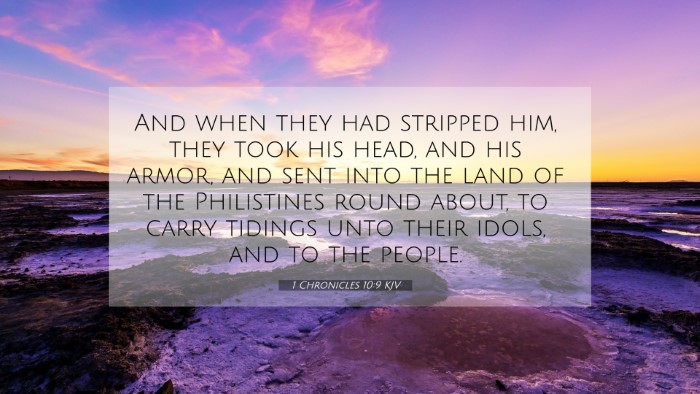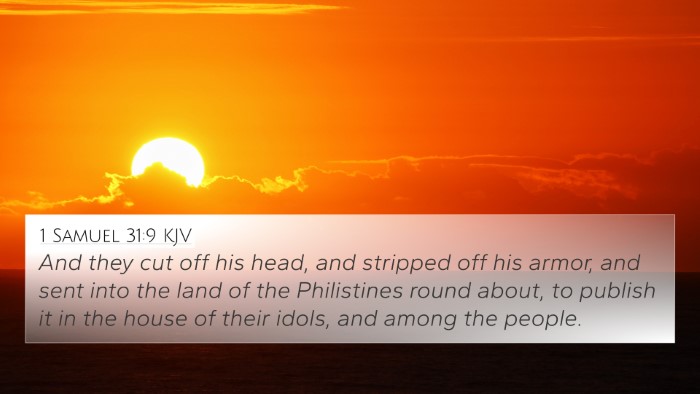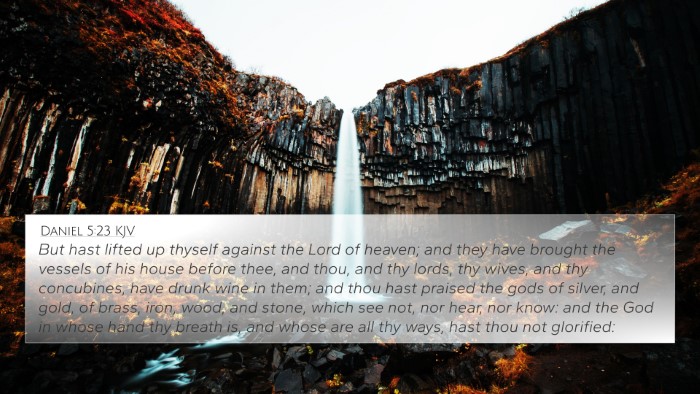Understanding 1 Chronicles 10:9
1 Chronicles 10:9 states: "And they stripped him, and took his head, and sent it away into the land of the Philistines round about, to carry tidings unto their idols, and to the people."
Summary of the Verse
This verse describes the brutal aftermath of King Saul's death, highlighting the actions of the Philistines who desecrate his remains by beheading him and parading his head as a trophy. It serves as a grim reminder of the consequences of defeat and the scorn the enemies of Israel harbored for their fallen king.
Commentary Insights
Matthew Henry’s Commentary
Matthew Henry emphasizes the shame and disgrace surrounding Saul’s death, noting that this act of displaying his head among their idols symbolizes the victory the Philistines believed they had over the God of Israel. This act also illustrates the prophetic warnings given regarding the fall of Saul.
Albert Barnes’ Notes
Albert Barnes discusses the cultural practices of the time, where displaying the heads of defeated enemies served as a way to instill fear. He notes the Philistines’ intent to spread the news of their conquest and uses their actions as a reflection of the futility of rebellion against God.
Adam Clarke's Commentary
Adam Clarke highlights the theological implications of the act, suggesting that the display of Saul’s head was not merely a show of victory but also a means to mock the people of Israel and their God. It served as a grim contrast to God's covenant people, contrasting the temporary triumph of their enemies with the eternal sovereignty of Yahweh.
Cross-References for 1 Chronicles 10:9
- 1 Samuel 31:9-10 - Provides the background of Saul's death and the Philistines' actions.
- Psalm 79:1 - Reflects on the desecration of the sanctuary, alluding to similar themes of disgrace.
- 2 Samuel 1:10-12 - Tells of the Amalekite who claimed to have killed Saul, showing the reverberating consequences of his death.
- 1 Chronicles 10:6 - Discusses the death of Saul, establishing continuity in the narrative.
- 2 Samuel 21:12-14 - Relates how David later avenged Saul's disgrace by retrieving his bones and giving him a proper burial.
- Job 18:17 - Comments on the legacy and memory of the wicked and how their names fade from memory, paralleling Saul's fall.
- Isaiah 14:9-15 - Depicts the downfall of the proud and might, echoing the fate of Saul as a warning to others.
Thematic Connections
This verse is rich in themes, including:
- Defeat and Despair: The physical act of beheading Saul symbolizes complete defeat and serves as a reminder of the consequences of straying from God's path.
- Idolatry: The Philistines’ display of the head among their idols raises themes of idolatry and the futility of trusting in false gods.
- Public Shaming: The public manner of displaying Saul's head reflects the cultural practices of warfare and the importance of conquest in ancient Near Eastern societies.
Applications for Study
When studying this verse, one can utilize various tools for Bible cross-referencing, such as:
- Bible concordance - A tool to find specific verses related to key terms.
- Bible cross-reference guide - Helps in finding verses that are thematically related.
- Cross-reference Bible study - A method for in-depth analysis of related scripture.
Conclusion
1 Chronicles 10:9 serves not only as a historical account of Saul's death but also offers profound insights into the nature of defeat, the consequences of sin, and the ultimate sovereignty of God. Through the lens of inter-Biblical dialogue, one can uncover layers of meaning that resonate with themes throughout Scripture.









